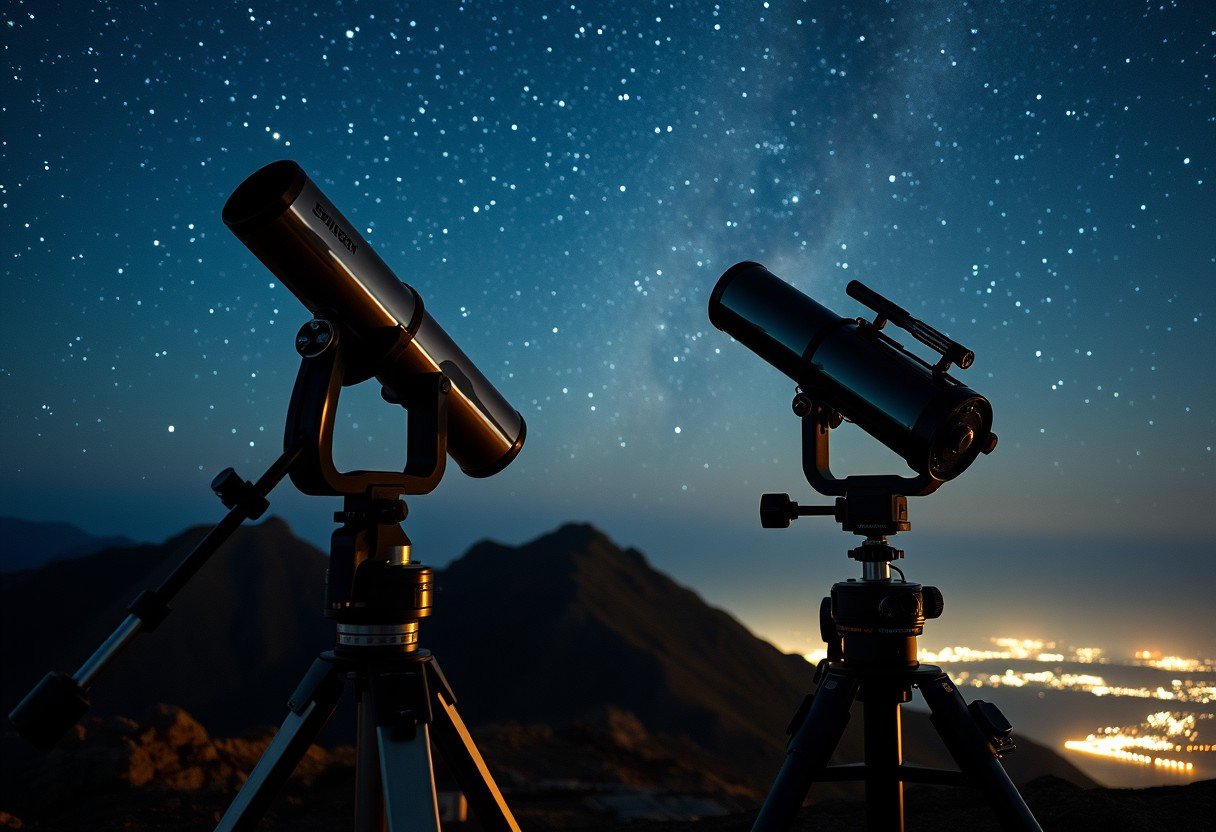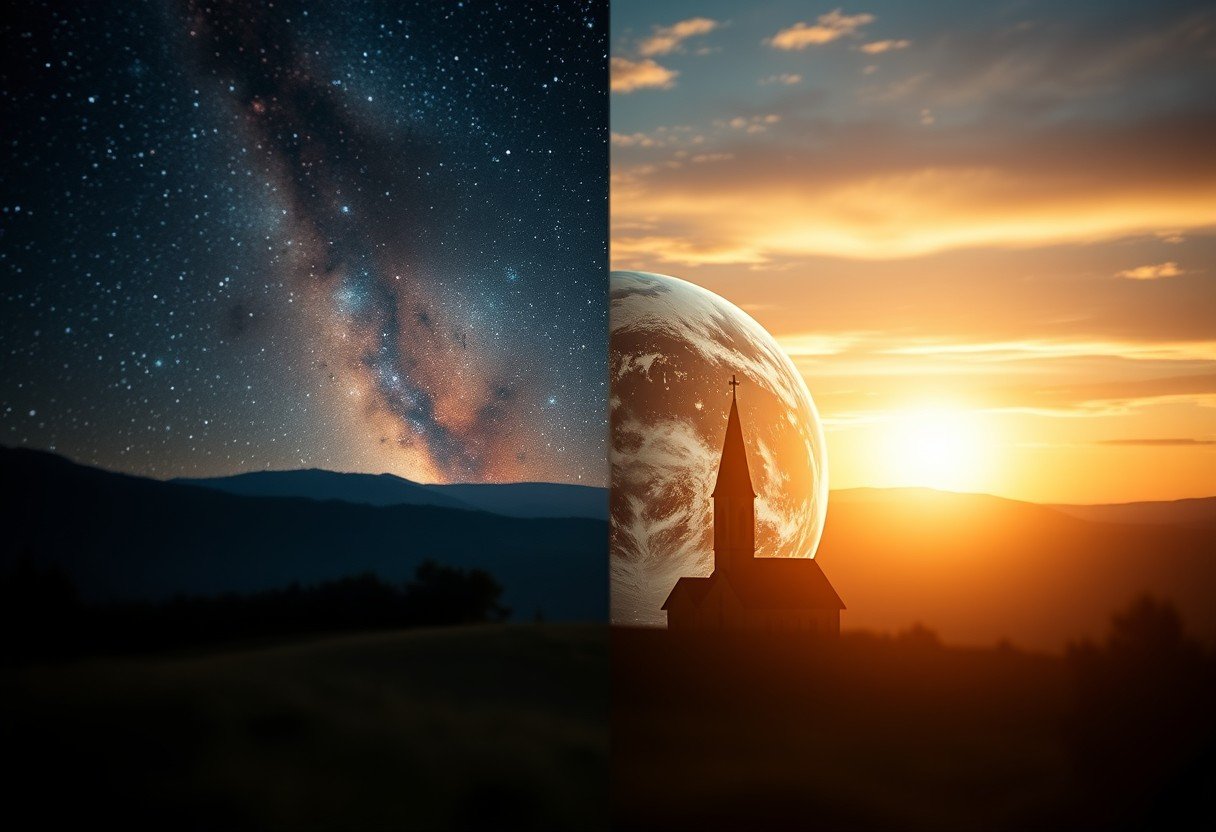When you look up at the night sky, you might wonder why astronomers are always building bigger telescopes. The reason is simple: a telescope’s main job is to collect light, and a bigger telescope acts like a larger bucket for catching faint light from distant stars and galaxies. An 8-meter telescope can see things a 2-meter telescope can’t, revealing secrets of the universe that would otherwise remain hidden. This difference in power is truly massive and easy to understand.
What is Telescope Aperture and Why Does it Matter?
The most important part of any telescope is its aperture. This is simply the diameter of the main light-gathering part, which is either a lens or a mirror. Think of it as the pupil of the telescope’s eye. The wider the aperture, the more light can enter the instrument at once.
Aperture size directly controls how bright and clear an object will appear. A small aperture can only collect a little bit of light, making faint objects like distant nebulae or galaxies completely invisible. A large aperture gathers much more light, making those same faint objects pop into view with surprising detail.
This is why the size of the aperture is the most critical factor for any serious astronomer. It not only determines how faint you can see but also improves the telescope’s resolving power, which is its ability to show fine details. More light means better contrast and sharper images.
The Simple Math Behind Light Gathering Power
You might think that a telescope twice as wide is twice as powerful, but the difference is much greater. The light a telescope collects depends on the area of its aperture, not just its diameter. The formula for the area of a circle is A = πr², where ‘r’ is the radius (half the diameter).
This simple formula reveals an incredible secret. Because the area increases with the square of the radius, doubling the diameter of a telescope actually quadruples its light-gathering area. This exponential increase is why astronomers are in a constant race to build bigger instruments.
When you compare an 8-meter telescope to a 2-meter one, the 8-meter scope has a diameter that is four times larger. To find the difference in light-gathering power, you just square that number (4 x 4). This means an 8-meter telescope gathers 16 times more light than a 2-meter telescope. This is not a small improvement; it is a giant leap in capability.
Comparing an 8-Meter and a 2-Meter Telescope in Numbers
Let’s look at the actual numbers to see the difference clearly. A 2-meter telescope has a radius of 1 meter. Using the area formula, its light-collecting surface is about 3.14 square meters. An 8-meter telescope has a radius of 4 meters, giving it a collecting area of approximately 50.27 square meters.
The raw numbers make the comparison very stark. The 8-meter telescope has a significantly larger surface to capture photons travelling from the deepest corners of space.
| Telescope Size | Light Gathering Area (m²) |
|---|---|
| 2-Meter Telescope | 3.14 |
| 8-Meter Telescope | 50.27 |
This huge difference in area is what allows larger telescopes to perform groundbreaking research. They can detect the faint glimmer of planets orbiting other stars or study the first galaxies that formed after the Big Bang.
What More Light Means for Stargazing
Having 16 times more light translates directly into better astronomical observations. For researchers and amateur astronomers alike, this increased power opens up a new window to the cosmos. It’s the difference between seeing a faint smudge and a glorious spiral galaxy with distinct arms.
More light fundamentally improves the quality of the data collected. It enhances the signal-to-noise ratio, meaning the actual light from the object (the signal) is much stronger compared to random interference (the noise). This results in cleaner, more detailed images and more precise scientific measurements.
With a larger telescope, you can achieve amazing things that are impossible with smaller instruments. The primary benefits include:
- Seeing Fainter Objects: You can detect stars, galaxies, and nebulae that are simply too dim to be seen with a smaller scope.
- Greater Detail: More light allows you to see finer structures in celestial objects, like the cloud bands on Jupiter or the dust lanes in a distant galaxy.
- Shorter Exposure Times: For astrophotography, a larger telescope can capture a high-quality image in a fraction of the time, reducing issues caused by atmospheric changes or tracking errors.
Ultimately, this enhanced capability is essential for pushing the boundaries of what we know about the universe. It allows for discoveries that can redefine our understanding of space and time.
Are Bigger Telescopes Always Better?
While a large aperture is the king of light gathering, it is not the only thing that determines a telescope’s performance. Several other factors can impact the quality of your view and the images you produce. A massive telescope with poor optics or one placed in a bad location will not perform at its full potential.
A telescope is a complex system, and its final performance depends on how well all its parts work together. For example, the quality of the mirrors or lenses is crucial. If they are not perfectly shaped and polished, they can distort the light and ruin the image, no matter how large the aperture is.
Atmospheric conditions also play a huge role. Turbulence in the Earth’s atmosphere, often called “seeing,” can make stars twinkle and blur fine details. This is why major observatories are built on high, dry mountains where the air is calm and clear. Light pollution from cities is another major problem that can wash out faint objects, even for large telescopes.
The Future of Giant Telescopes
The quest for more light continues to drive innovation in telescope design. The next generation of extremely large telescopes promises to revolutionize astronomy once again. These massive instruments, with mirrors stretching 30 meters or more, will be able to see farther and with more clarity than ever before.
These future telescopes will incorporate incredible technology to overcome challenges like atmospheric distortion. Using systems called adaptive optics, they can change the shape of their mirrors hundreds of times per second to cancel out the blurring effect of the atmosphere. This will allow them to achieve images as sharp as those from space-based telescopes.
With these future observatories, astronomers hope to answer some of the biggest questions in science. They will be able to search for signs of life in the atmospheres of exoplanets, study the nature of dark matter and dark energy, and watch the very first stars ignite in the early universe.
Frequently Asked Questions about Telescope Light Gathering
How does the size of a telescope affect its light-gathering ability?
The ability to gather light is related to the area of the main mirror or lens. This area increases with the square of the diameter, so doubling a telescope’s size makes it four times more powerful at collecting light, allowing it to see much fainter objects.
How can we calculate the light-gathering power of an 8-meter telescope compared to a 2-meter telescope?
You compare the ratio of their diameters and square it. An 8-meter telescope is four times wider than a 2-meter one (8 / 2 = 4). Squaring this number (4²) gives you 16, meaning the 8-meter telescope collects 16 times more light.
What advantages does gathering more light provide for astronomical observations?
More light allows astronomers to see fainter and more distant objects. It also improves image quality by increasing detail and reducing noise, which is crucial for making precise scientific measurements and discovering new celestial phenomena.
Are there any drawbacks to using a larger telescope?
Yes, larger telescopes are much more expensive to build, maintain, and house. Their massive mirrors or lenses are difficult to manufacture perfectly, and they require very stable structures and advanced tracking systems to operate effectively.
How does the distance to celestial objects affect the advantage of using a larger telescope?
The advantage is most significant for very distant objects. Light from these objects has spread out over vast distances, making them appear extremely faint. A larger telescope’s superior light-gathering power is essential to collect enough of this faint light to detect and study them.









Leave a Comment